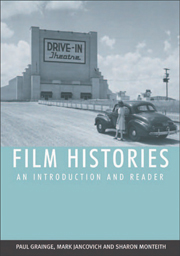Book contents
- Frontmatter
- Contents
- Preface
- Part I Film History from its Origins to 1945
- Part II Film History from 1946 to the Present
- 13 Postwar Challenges: National Regeneration, HUAC Investigations, Divestiture and Declining Audiences
- 14 The Politics of Polarisation: Affluence, Anxiety and the Cold War
- 15 Cinematic Spectacles and the Rise of the Independents
- 16 New Waves, Specialist Audiences and Adult Films
- 17 Radicalism, Revolution and Counter-Cinema
- 18 Modernism, Nostalgia and the Hollywood Renaissance
- 19 From Movie Brats to Movie Blockbusters
- 20 The Exhibitors Strike Back: Multiplexes, Video and the Rise of Home Cinema
- 21 Postmodernism, High Concept and Eighties Excess
- 22 Cults, Independents and ‘Guerrilla’ Filmmaking
- 23 From Cinemas to Theme Parks: Conglomeration, Synergy and Multimedia
- 24 Globalisation and the New Millennium
- Bibliography
- Copyright Acknowledgements
- Index
24 - Globalisation and the New Millennium
from Part II - Film History from 1946 to the Present
Published online by Cambridge University Press: 05 August 2013
- Frontmatter
- Contents
- Preface
- Part I Film History from its Origins to 1945
- Part II Film History from 1946 to the Present
- 13 Postwar Challenges: National Regeneration, HUAC Investigations, Divestiture and Declining Audiences
- 14 The Politics of Polarisation: Affluence, Anxiety and the Cold War
- 15 Cinematic Spectacles and the Rise of the Independents
- 16 New Waves, Specialist Audiences and Adult Films
- 17 Radicalism, Revolution and Counter-Cinema
- 18 Modernism, Nostalgia and the Hollywood Renaissance
- 19 From Movie Brats to Movie Blockbusters
- 20 The Exhibitors Strike Back: Multiplexes, Video and the Rise of Home Cinema
- 21 Postmodernism, High Concept and Eighties Excess
- 22 Cults, Independents and ‘Guerrilla’ Filmmaking
- 23 From Cinemas to Theme Parks: Conglomeration, Synergy and Multimedia
- 24 Globalisation and the New Millennium
- Bibliography
- Copyright Acknowledgements
- Index
Summary
In the 1980s and 1990s, the overseas market counted for half of the majors' theatrical income and generated an even greater percentage of revenue through home video and television. The development and exploitation of world markets, specifically the rich and densely populated regions of Europe and Asia, led to strategic concerns with the global dimensions of film. This not only included questions about cinematic form, but also had significant implications for production, financing and labour practice.
In terms of the physical labour involved in the production of movies, Hollywood sought increasingly to exploit cheap labour markets during the 1990s. Similar to retail and manufacturing industries that source products using inexpensive factory labour, notably in Asia and South America, the film majors used ‘runaway production’ to keep down labour costs and to avoid troublesome domestic unions. Disney, for example, outsourced much of its animation work to Asia, where inkers and colourists were a lot cheaper to employ. At the same time, English-speaking countries such as Canada, Australia, New Zealand and the United Kingdom became emerging centres for runaway film production, a combination of tax incentives, currency imbalances and labour bargains meaning that studios could get more for their money using overseas production facilities.
While no big-budget movies were made overseas in 1990, twenty-four were made in 1998. Films such as Titanic (Mexico, 1997), The Matrix (Australia, 1999), Mission: Impossible (United Kingdom, 1996), Mission: Impossible 2 (Australia, 2000), the The Lord of the Rings trilogy (New Zealand, 2001–3), and The Bourne Identity (Czech Republic, 2002) all drew upon offshore labour and studio facilities.
- Type
- Chapter
- Information
- Film HistoriesAn Introduction and Reader, pp. 550 - 573Publisher: Edinburgh University PressPrint publication year: 2007



